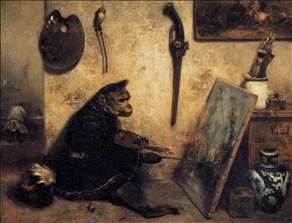French painter, draughtsman and printmaker. With his brother Maurice-Alexandre (1804-52), the art critic and essayist, he spent some years of his youth at Orsay, in Picardy, in order to learn to rise early and know the hard life of the fields . The artwork of the peasants stimulated an interest in drawing. He entered the atelier of Etienne Bouhot (1780-1862) in 1816. Towards the end of 1818 he left Bouhot to study under Alexandre-Denis Abel de Pujol, quitting his studio in 1819-20 in order to embark upon a career as an independent professional artist. Memories of Orsay remained his point of departure throughout his working life, and in this sense he was a self-trained artist. Nevertheless, he admired, and learnt from the art of such diverse artists as
Raphael, Titian, Giovanni da Bologna,
Poussin, Rembrandt,
Gricault and
Lopold Robert. In his youth he travelled in the East, and reproduced Oriental life and scenery with a bold fidelity to nature that made his works the puzzle of conventional critics. His powers, however, soon came to be recognized, and he was ranked along with
Delacroix and Vernet as one of the leaders of the French school. At the Paris Exhibition of 1855 he received the grand or council medal.
Most of his life was passed in the neighbourhood of Paris. He was passionately fond of animals, especially dogs, and indulged in all kinds of field sports. He died on the 22nd of August 1860 in consequence of being thrown from a vicious horse while hunting at Fontainebleau.
His subjects embraced an unusually wide range. He availed himself of his travels in the East in dealing with scenes from Scripture history, which he was probably the first of European painters to represent with their true and natural local background. Perhaps the most impressive of his historical pictures is his
Defeat of the Cimbri, representing with wonderful skill the conflict between a horde of barbarians and a disciplined army.
Decamps produced a number of genre pictures, chiefly of scenes from French and Algerian domestic life, the most marked feature of which is humour. The same characteristic attaches to most of his numerous animal paintings. He painted dogs, horses, etc., with great fidelity and sympathy; but
his favourite subject was monkeys, which he depicted in various studies and sketches with a grotesque humour. Probably the best known of all his works is The Monkey Connoisseurs, a clever satire of the jury of the French Academy of Painting, which had rejected several of his earlier works on account of their divergence from any known standard.



